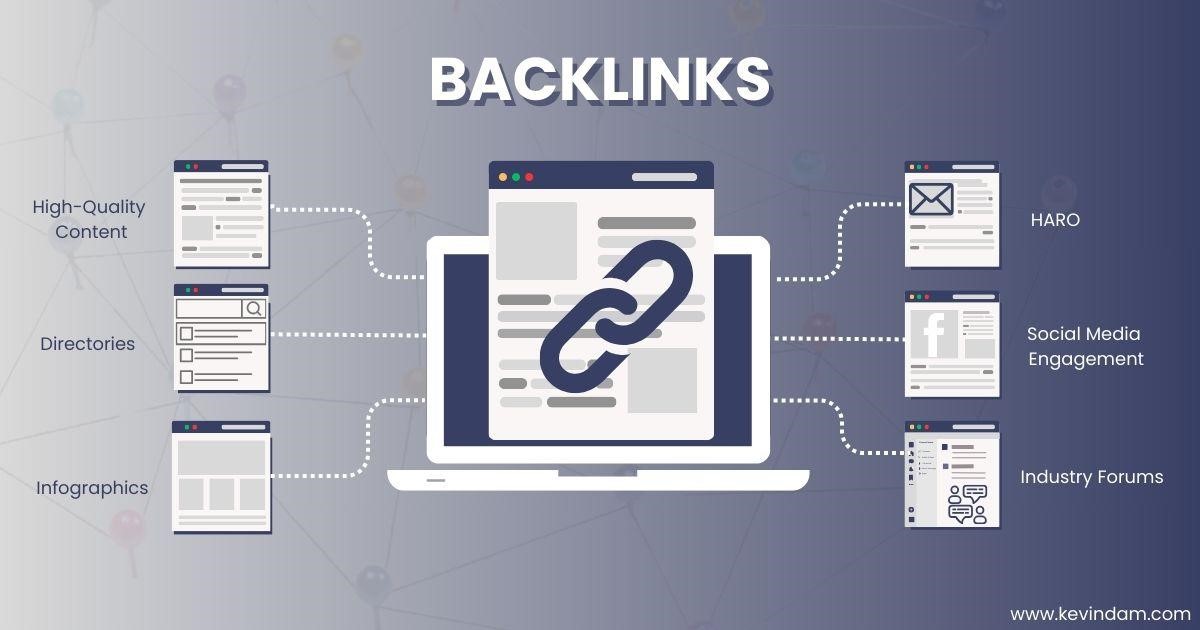
Last Updated August 24, 2024
Backlinks 101: A Comprehensive Guide to SEO Link Building Strategies
Backlinks are essential for a strong SEO strategy. These links from other websites to yours act as endorsements, demonstrating to search engines the credibility and quality of your content. However, not all backlinks carry the same weight. To make the most of backlinks for SEO, you need to understand the different types, how to acquire high-quality links, and effectively maintain a solid backlink profile.
This article discusses the importance of backlinks in SEO, categorising them by type, each contributing uniquely to your website’s ranking and credibility. It provides strategic insights into acquiring high-quality backlinks through methods like guest posting and using tools such as Ahrefs to monitor backlink health. The significance of ethical link-building practices is also highlighted to enhance and sustain online visibility and authority, with advice against unethical black hat practices.
The Significance of Backlinks in SEO
Backlinks are like recommendations from other sites. When a respected site links to your content, it’s like getting a thumbs-up from an expert. Just like you wouldn’t want to connect with unreliable sources, ensure your online links come from credible and reputable sources.
What Makes an Effective Backlink Strategy?
Before we explore each tactic in-depth, let’s first understand the key characteristics of a successful backlink strategy:
- Relevance: Focus on acquiring backlinks from websites and content closely related to your niche or industry for relevance.
- Authority: Prioritise backlinks from high-authority domains as they carry more weight in the eyes of search engines for authority.
- Diversity: Aim for a diverse backlink profile with links from various types of websites (blogs, news sites, directories, etc.)
- Quality: Ensure the linking content is high-quality, well-written, and provides value to readers.
Impact of High-quality Backlinks
Search engines like Google view these as validations of your website’s credibility and relevance. Here are some advantages of high-quality backlinks on SEO:
- Improved Search Rankings: Pages with quality backlinks rank higher in search results.
- Increased Referral Traffic: Backlinks from popular websites can drive targeted traffic to your site.
- Greater Authority and Credibility: Earning links from respected sites positions your brand as a trusted source.
A study by Ahrefs found that the number of referring domains linking to a page strongly correlated with higher Google rankings. In short, the more quality websites link to you, the better your chances of ranking well.
Quality backlinks from industry-related sources are especially valuable, showing relevance and usefulness to search engines. Always remember that the focus should be on high quality rather than quantity of backlinks to enhance a website’s reputation and visibility online.
Having covered the influence of backlinks, let’s examine the different backlink types their SEO effects.
Types of Backlinks
Understanding the different types is key to developing an effective link-building strategy. Let’s break down the three main categories—inbound, outbound, and internal backlinks. Each serves a unique purpose in enhancing a website’s credibility, relevance, and authority.
Inbound Backlinks
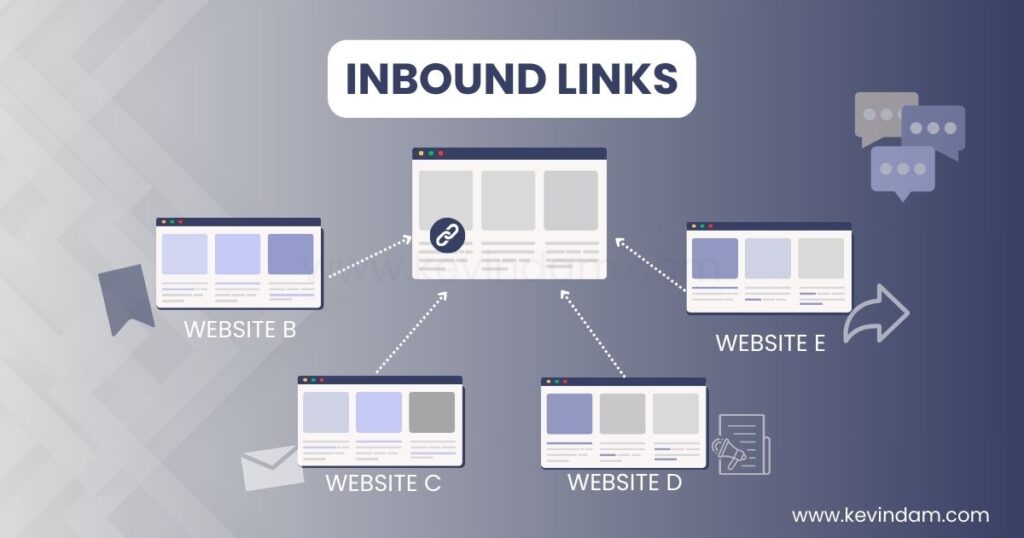
Links from other sites point to your website. These are the most valuable for SEO. These links signal the value and reliability of your content.
These inbound links are similar to recommendations from esteemed figures in the industry. Just like how a renowned chef endorsing a restaurant elevates its reputation, inbound backlinks from reputable and relevant sources within your niche boost your site’s standing in the eyes of search engines.
Outbound Links
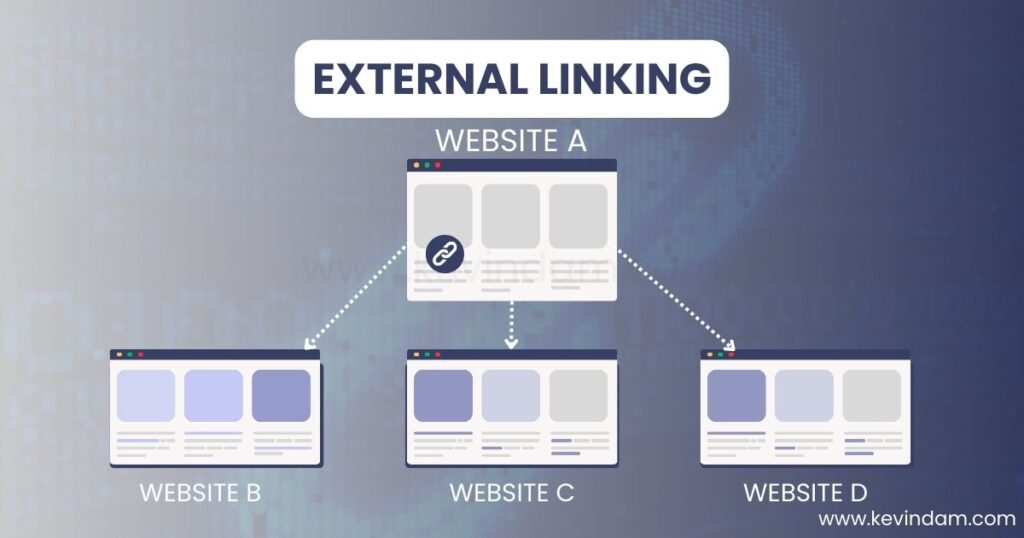
Links from your site to external websites. When linking your site to external websites, the impact on SEO may be less, but connecting to relevant, authoritative sources can boost your content’s credibility. These links offer more context and resources for your readers, opening up opportunities to build connections with reliable sources naturally.
By incorporating outbound links thoughtfully, you add substantial value to your content by establishing credibility through association with reputable sources. Much like referencing scholarly work in an academic paper enhances its authority, linking to respected sites bolsters the substance and trustworthiness of your content.
Internal Backlinks
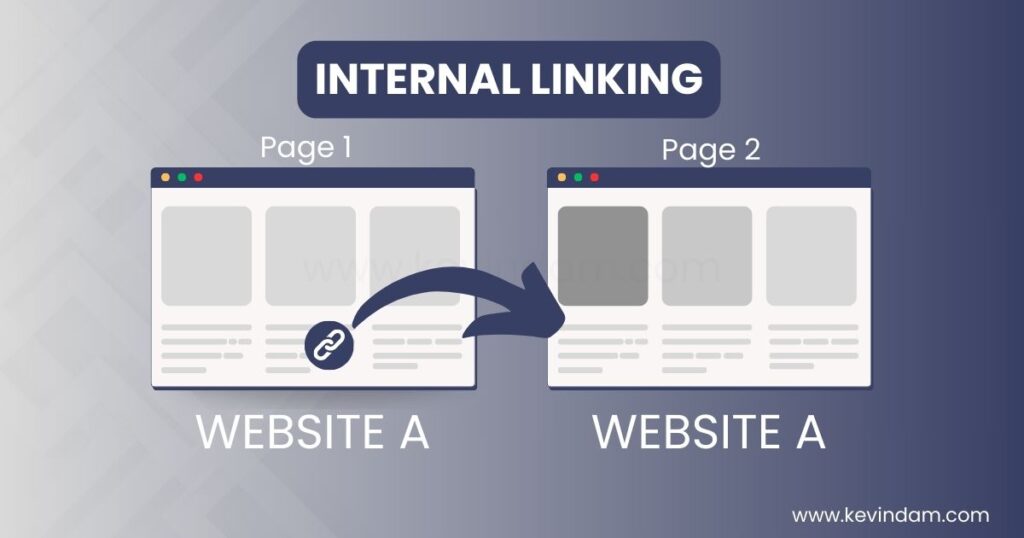
Think of internal backlinks as the maps that guide visitors through a detailed journey across your digital space. They help search engines grasp your site’s layout and importance while enhancing user experience by offering easy access to related info. This structured linking spreads page authority on your site, boosting the credibility and relevance of all content and creating a strong web presence.
While inbound links are the primary focus for SEO, a balanced link profile incorporating all three types is ideal. With a solid foundation on backlink varieties, let’s explore effective strategies for acquiring high-quality backlinks to bolster your website’s SEO performance.
Strategies for Acquiring High-Quality Backlinks
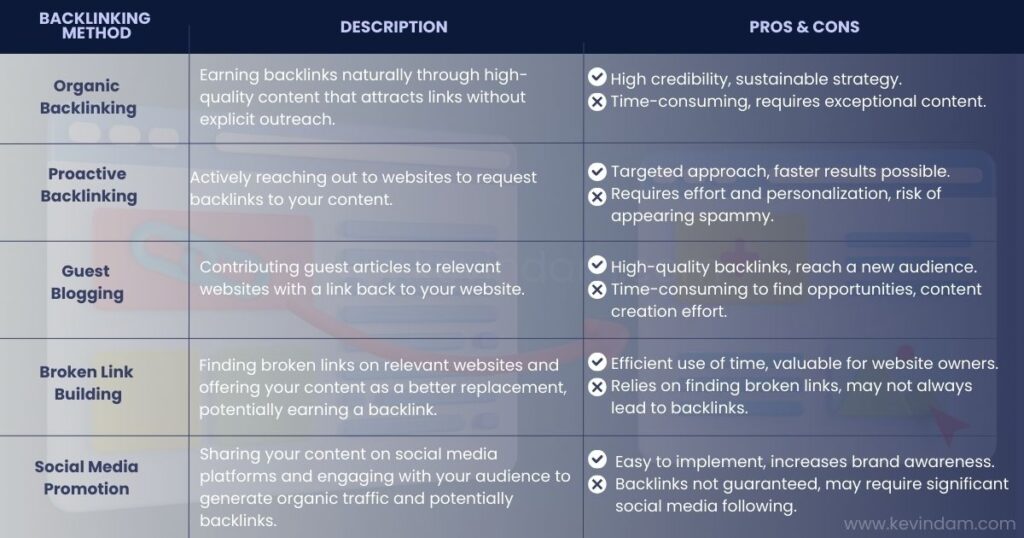
Regarding link building, acquiring high-quality backlinks is crucial for enhancing your website’s authority and search engine rankings. We’ll explore effective strategies that promote organic backlink acquisition and contribute to a robust link profile.
Building a strong backlink profile takes effort and persistence. Here are four proven tactics to earn valuable links:
1. Guest Posting for Targeted Backlinks
Sharing high-quality guest posts on reputable websites within your niche is a win-win strategy for backlink building. When you contribute well-crafted, informative articles to these platforms, you enhance your brand’s visibility and gain authoritative backlinks to your site. This mutually beneficial partnership enhances your site’s authority and boosts referral traffic from the hosting website.
Guest posting is akin to speaking at a prestigious industry conference — sharing valuable insights with a wider audience establishes your authority in the field, fostering meaningful connections and opportunities. To maximise the impact of guest posting for SEO:
- Target blogs with engaged audiences and strong domain authority.
- Craft unique, valuable content that aligns with the blog’s themes.
- Include a natural, keyword-optimised link to your site in the author bio or body.
2. Broken Link Building
Identifying broken links on high-authority websites and offering relevant content to replace the dead source presents a win-win opportunity. Assisting webmasters in fixing broken links with your resourceful content enhances user experience and secures valuable backlinks from reputable sources. This method requires keen observation and an understanding of your content’s relevance to the broken link. Tools like Ahrefs’ Site Explorer can quickly help you find broken link opportunities.
Imagine discovering a broken link on an influential industry blog pointing to outdated statistics. Offering your updated and relevant research findings as a replacement not only assists the website in resolving the issue but also gains a valuable backlink in return.
This tactic works because:
- You’re providing value by alerting site owners to broken links.
- You’re positioning your content as a solution, increasing the chances of earning a link.
3. Resource Page Link Acquisition
Resource pages are curated lists of helpful links and resources on a specific topic. Crafting valuable assets that naturally attract links is the foundation of a sustainable link-building strategy. Original research, comprehensive guides, compelling infographics, and insightful industry reports are the types of content that other websites seek to reference and share with their audience. Crafting unique and authoritative resources can help you position your website as an industry leader and attract natural backlinks from reputable sources.
For instance, original research studies on industry trends or consumer behaviour can be authoritative references for other publishers. Similarly, in-depth guides offering actionable insights or compelling infographics that visually represent complex data can become go-to resources for websites seeking valuable content to link to.
According to a study, Buffer, a social media management platform, secured a backlink from an authoritative resource page on social media marketing, resulting in a 25% increase in referral traffic.
Aim to produce resources that are:
- Original and unique
- Comprehensive and in-depth
- Practical and actionable
- Visually engaging (infographics, videos, charts, etc.)
4. Skyscraper Content Creation
The Skyscraper technique by Brian Dean aids in link building by creating exceptional content that outshines existing ones, attracting backlinks naturally. This process involves:
- Identifying popular content in your niche
- Creating an improved version
- Promoting it to sites linking to the original content
For example, if a top-ranking article for “backlinks in SEO” was outdated, you could create a more comprehensive, up-to-date guide and reach out to sites linking to the original piece, suggesting your resource as a replacement. Providing a superior piece of content increases your chances of earning high-quality links.
4. Influencer Outreach
Engaging with influencers and thought leaders in your niche can boost your content’s reach and gain valuable backlinks. Seek feedback from prominent figures on your latest content, as their endorsements can enhance credibility and visibility. Implementing these strategies can help you establish a strong foundation for acquiring quality backlinks, boosting your website’s credibility and visibility online.
5. Competitor Analysis
Staying ahead of your competition is crucial to improve your backlink profile. Conducting a competitor analysis can help you identify their top-performing content and the websites linking to it. You can then reach out to these websites and offer them an even better piece of content, increasing your chances of earning backlinks from high-authority sources.
6. Social Bookmarking
Saving and sharing web pages for easy access and sharing within a social network. Social bookmarking involves saving website links to a public platform for easy access and sharing. This backlink strategy can boost a website’s visibility and drive traffic by creating valuable links from bookmarking sites.
7. Directory Submissions
Adding website details to online directories for increased visibility. Directory submissions are a backlink strategy where website URLs are submitted to online directories to improve search engine visibility. This can positively impact a website’s SEO by increasing its backlink profile and domain authority.
How it’s done:
- Submit your website URL to online directories like Yelp, Yellow Pages, and Google My Business.
- Choose relevant categories and subcategories for your business when submitting to directories.
- Ensure consistent business information (name, address, phone number) across all directories for better SEO.
8. Digital PR and Media Coverage
Digital PR involves promoting your brand, content, or expertise to journalists, bloggers, and media outlets to earn press mentions and backlinks. By positioning yourself as a thought leader and pitching compelling stories, you can acquire high-authority backlinks and boost your website’s visibility.
To land media coverage and backlinks:
- Monitor HARO (Help a Reporter Out) for relevant journalist requests in your niche
- Craft compelling, data-driven pitch angles showcasing your unique insights or experiences
- Build relationships with journalists and bloggers by engaging with their content and providing value
As we continue to explore effective SEO strategies, let’s shift our focus to discussing the tools to the tools needed to effectively monitor backlink performance.
Key Tools to Monitor Backlink Performance
Monitoring and analysing your backlink profile is essential for ensuring the health and effectiveness of your SEO strategy. Utilising reputable SEO tools such as Ahrefs, Moz, and SEMrush can provide invaluable insights into the quantity, quality, and performance of your backlinks, allowing you to make informed decisions about your link-building efforts.
These advanced tools offer a wide range of features to help track your backlink progress and identify areas for improvement, providing comprehensive data on the websites linking to your domain. Understanding the authority and relevance of each backlink is crucial for gauging its impact on search engine rankings and organic traffic. These tools also automate the backlink checking process, send notifications of changes, and offer disavow list features, saving you significant time and effort in effectively managing your backlink portfolio.
Ahrefs
Ahrefs is well-known for its impressive crawling speed and in-depth backlink analysis. It offers detailed information about the referring domains, anchor texts, and insights into any Google penalties affecting your backlink profile. This level of detail empowers you to make informed decisions about disavowing toxic links and optimising your link-building strategy.
Moz
Moz, on the other hand, provides valuable metrics such as Domain Authority and Page Authority, which are instrumental in evaluating the overall strength of your backlink profile. By regularly monitoring these metrics, you can gauge the effectiveness of your link-building efforts and identify areas where you need to improve.
SEMrush
SEMrush offers solutions for both analysing existing backlinks and building new ones. Its detailed data on existing links, export feature to Disavow Tool, and solutions for building new links make it an all-in-one tool for maintaining a healthy backlink profile.
These SEO tools enable you to analyse individual backlinks with precision, examining their quality, source, and impact. This empowers you to stay ahead of algorithm updates, identify potential spammy or low-quality links that could affect your rankings, and uncover opportunities to secure high-quality backlinks in competitive niches.
With these powerful tools, you can gain deeper insights into your backlink performance and make strategic decisions to strengthen your SEO efforts.
Mitigating Risks and Challenges in Link-Building
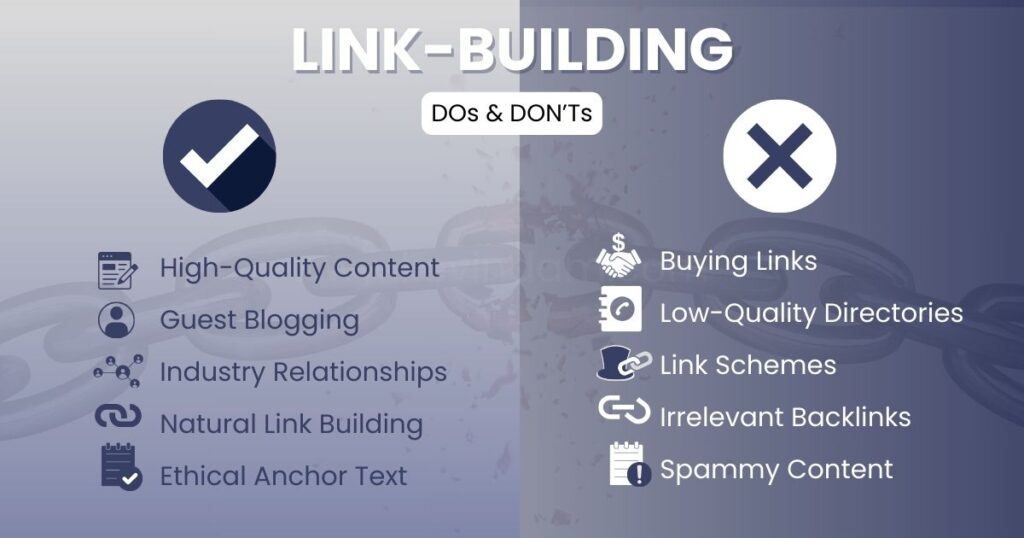
Link-building remains crucial to SEO, presenting its fair share of risks and challenges. While gaining backlinks can significantly boost your website’s authority and visibility, engaging in questionable or unethical practices could greatly impact your site’s online presence.
Here are some factors you should consider to avoid risks:
- Avoid Black Hat SEO.
Be cautious of using black hat SEO practises such as buying backlinks, participating in link schemes, or spamming. These unethical strategies can provide short-term gains but ultimately jeopardise your site’s long-term success. Search engines like Google regularly update their algorithms to detect and penalise websites that manipulate backlinks through these forbidden techniques. Such penalties can result in a significant drop in search rankings or even being completely removed from search results, causing serious harm to your online visibility.
- Prioritise Quality over Quantity.
It’s important to emphasise the significance of prioritising quality over quantity when it comes to backlink acquisition. Instead of accumulating many backlinks, our approach should align with ethical and sustainable practises, contributing to our website’s credibility and reliability.
Imagine building a house – you wouldn’t choose to construct it with cheap, flimsy materials that compromise the structure’s integrity just to finish quickly, would you? Similarly, you must prioritise valuable, authoritative backlinks relevant to your content rather than opting for quick but low-quality links that can damage our site’s reputation in the long run.
- Regularly review backlink profile.
Regular review and maintenance of our backlink profile is also crucial. You must actively monitor and disavow toxic or irrelevant backlinks that may harm our site’s reputation and SEO performance. This process involves identifying unnatural or harmful links pointing to our site and asking search engines not to consider them when assessing our website’s ranking.
Staying vigilant against these potential risks and challenges can help build a robust backlink profile that enhances your site’s visibility while safeguarding its integrity and reputation. Steer clear of unethical practises and prioritising quality over quantity to pave the way for sustainable growth in website visibility and credibility.
Conclusion
Incorporating a solid backlink strategy is crucial for boosting search engine rankings and establishing your website’s authority. Understanding various backlink types and prioritising high-quality links through ethical means can significantly enhance your online visibility. Following the strategies outlined in this guide will also help you create a diverse and reputable backlink profile, leading to increased organic traffic and improved SEO outcomes for your site.
